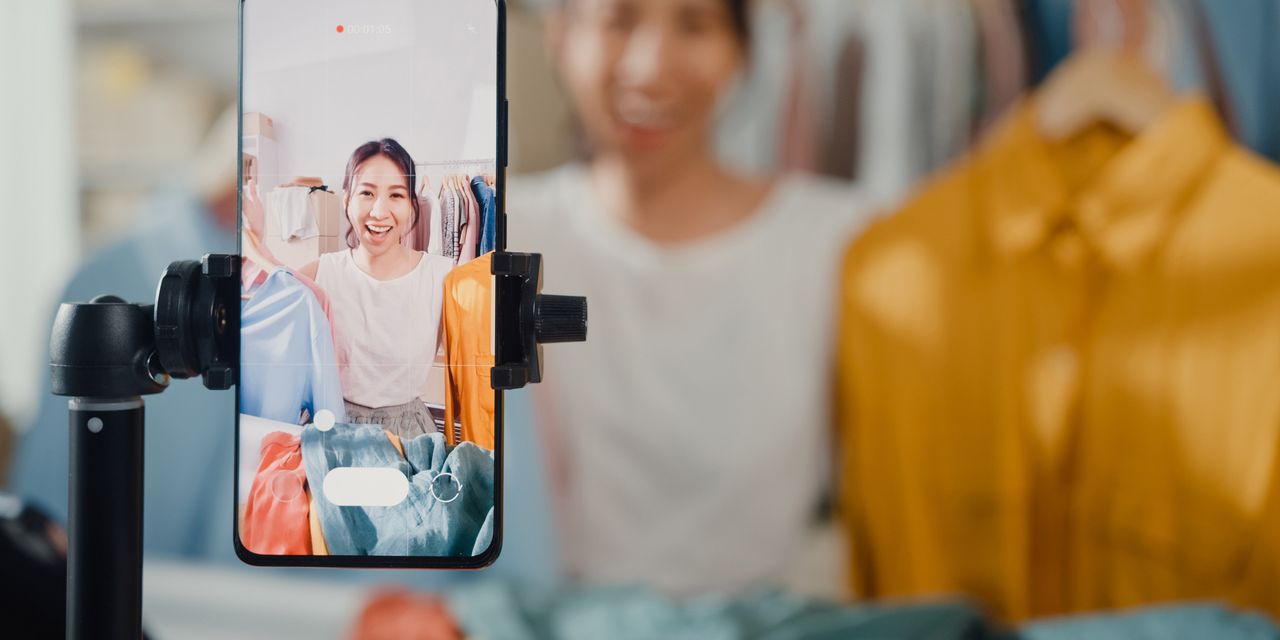When Ziwei Cong bought some sweatpants that caught her eye during a livestream shopping event on social media, she was disappointed when they arrived and didn’t fit well.
“It’s very easy for me to become irrational during these kinds of shopping events,” says the assistant professor of marketing at Georgetown University’s McDonough School of Business. She adds that the hosts can be very persuasive and hook you with limited- time offers to trigger impulse purchases.
Social shopping, or purchases made through social media sites that sometimes incorporate livestreaming events with influencers, is booming. Almost half of U.S. consumers (47%) say they’ve made a purchase on social media, and 39% say they have bought that way and would do so again, according to 2022 data in a report released in April by the market intelligence agency Mintel.
“Shopping on social media has really taken off more with younger consumers. They’re on their phones more and on social media more often, so it’s easier to purchase via social media when they find a product they like,” says Katie Hansen, senior retail and e-commerce analyst at Mintel and author of the report.
Despite its popularity, social shopping also comes with risks, most notably overspending, as Cong’s experience illustrates. The excitement, discounts and limited quantities can lead to unplanned (and regrettable) purchases. Shopping experts suggest the following guideposts when engaging in social shopping.
Read: Don’t get stung by buy-now- pay-later services: ‘It is kind of a recipe for disaster if not managed carefully’
Proceed slowly
Social shopping so easily leads to overspending, Cong says, because it’s so engaging. “It’s a more direct and interactive way to communicate with consumers, and it boosts the perceived experience of the product,” she explains, especially if a shopper sees their favorite influencer using the product.
The flash sales and limited promotions contribute to that rush to purchase, as does the “herding effect” from seeing other people leave comments and express their desire to buy, Cong adds.
To resist those temptations, shopping expert Trae Bodge from truetrae.com suggests slowing down and even stepping away from the screen. “Make sure it’s something you want. The sense of excitement and urgency might make you buy something that you haven’t properly vetted,” she adds. “It’s always good to take a beat.”
Budgeting expert Andrea Woroch says that if you see something appealing pop up in your feed, instead of buying it immediately, save the link to come back to later, after you take time to consider your budget. “That will avoid any buyer’s remorse,” she says.
Don’t miss: Prime Day is coming: How to make the most of sales from Amazon and competing retailers
Compare prices and check reviews
Bodge also encourages shoppers to check other websites for lower prices, look for coupons and leverage cash-back options that might be available outside of social shopping, such as on retailer or brand sites.
Woroch suggests checking customer reviews, too. “Do your homework like you would on another shopping site to make sure it’s the quality you expect. A lot of people overlook that when they do social shopping,” she says — one reason why the “what I ordered vs. what I got” meme is so popular on social media.
In some cases, making returns for items purchased through social shopping can be more of a hassle, so it’s worth checking the return policy in advance, Woroch also notes.
Plus: ‘This is a game changer’: Ahead of Amazon Prime Day, a new law makes it harder for online sellers to hawk fake or stolen products
Keep personal information private
Though social shopping can feel like a community experience, it’s worth remembering that your public comments are visible to strangers, and it’s important to keep personal details private, Bodge says. “Don’t overshare, and never put your credit card or address in the comments,” she adds.
Bodge also advises against leaving the social media platform to enter payment information on a third-party site, which could be a scam, and she encourages people to use a credit card to make purchases for added fraud protection.
Woroch notes that phones will sometimes automatically connect to available public Wi-Fi networks, which can leave you vulnerable to hackers when you are sharing payment information online. She suggests avoiding social shopping on public Wi-Fi networks.
From the archives (Oct. 2022): TikTok will use your data to fuel its multibillion-dollar shopping mall — whether you know it or not
Then, reap the rewards
With those precautions in place, social shopping can be a positive experience for consumers, especially because it allows them to connect directly with brands, including those they might not have otherwise been exposed to through a retailer, says Edward Fox, professor of marketing at Southern Methodist University’s Cox School of Business.
“It democratizes the commercial world and allows smaller brands to get a broader audience than they would otherwise,” he says.
It gives consumers more choices, too.
More From NerdWallet
Kimberly Palmer writes for NerdWallet. Email: [email protected]. Twitter: @kimberlypalmer.
Read the full article here




